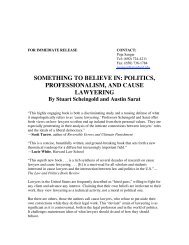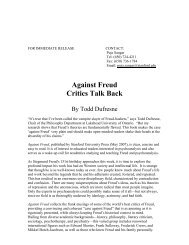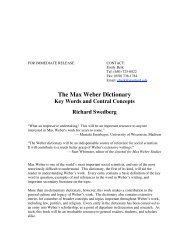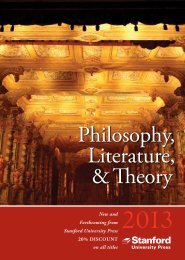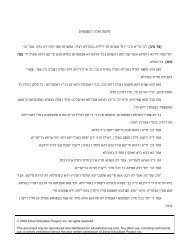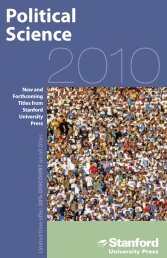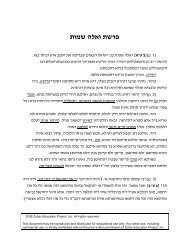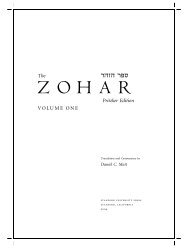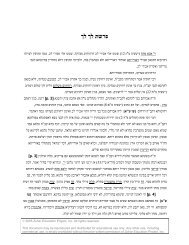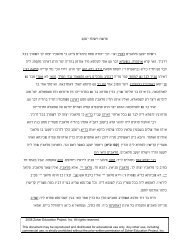Chapter 1 (PDF) - Stanford University Press
Chapter 1 (PDF) - Stanford University Press
Chapter 1 (PDF) - Stanford University Press
Create successful ePaper yourself
Turn your PDF publications into a flip-book with our unique Google optimized e-Paper software.
is that? The one included by the blessed Holy One when He said Iam<br />
Who 224<br />
YHVH.<br />
My Sabbaths are a circle with a square inscribed within. 225<br />
GNMK<br />
And they [heaven and earth] were completed ...(Genesis 2:1±3); 226<br />
(Vaykhullu),<br />
and in the qiddush that we recite there are thirty-five words, 228<br />
to seventy names of the blessed Holy One, 229 with which Assembly<br />
amounting<br />
Israel is adorned. 230 Since this circle and square are My Sabbaths, they are<br />
of<br />
and is reflected in His daughter, who<br />
``awe''<br />
lower Ḥokhmah.<br />
is<br />
I am YHVH The full verse reads:<br />
224.<br />
Sabbaths you are to observe, My sanctu-<br />
My<br />
you are to hold in awe, I am YHVH (Leviticuary<br />
19:30). Through Shekhinah, God re-<br />
the full spectrum of divine personalitveals<br />
and is thus called I. In this phrase, I is<br />
with YHVH (Tif'eret). Shekhinah manifests<br />
joined<br />
in both sacred time (Sabbath) and<br />
space (sanctuary).<br />
sacred<br />
circle with a square inscribed<br />
225.<br />
cf. Bahir 83 (114±16). Here the reference<br />
76b;<br />
to the higher sefirot (beginning with Binah<br />
is<br />
culminating in Yesod) andShekhinah.<br />
and<br />
KP; Scholem. Cf. Zohar 2:127a, where<br />
See<br />
circle of the letter S (samekh) symbolizes<br />
the<br />
while the square of the letter O (final<br />
Binah,<br />
of the qiddush (``hallowing, sanctification''),<br />
lines<br />
the prayer recited over wine Friday<br />
which includes the blessing over<br />
prayer,<br />
and the blessing of hallowing the<br />
wine<br />
Sabbath.<br />
in the qiddush that we recite...<br />
228.<br />
O (ki vanu vaḥarta ve-otanu qiddashta mi-<br />
KPTF<br />
ha-ammim), ``forYou have chosen us and<br />
kol<br />
us from among all nations.''<br />
hallowed<br />
Scholem, 493 (unnumbered); Ta-<br />
See<br />
Ha-Nigleh she-ba-Nistar, 63, 138±39,<br />
Shma,<br />
159. The Zohar's phrase ``that we recite''<br />
n.<br />
a particular custom, which differs<br />
indicates<br />
the standard qiddush.<br />
from<br />
seventy names... See Bemidbar<br />
229.<br />
14:12; Naḥmanides, Kitvei Ramban,<br />
Rabbah<br />
cf. Zohar 2:207b. Forvarious lists of<br />
1:135;<br />
names, see Alfa Beita de-Rabbi Aqiva<br />
these<br />
Midrashot, 2:350±51); Shir ha-Shirim<br />
(Battei<br />
1:1; Midrash ha-Gadol, Genesis 46:8;<br />
Zuta<br />
Ba'al ha-Turim, Numbers 11:16.<br />
and<br />
Yisra'el). In rabbinic Hebrew this<br />
(Keneset<br />
denotes the people of Israel. The<br />
phrase<br />
on the Song of Songs describes the<br />
midrash<br />
affairbetween the maiden (the earthly<br />
love<br />
of Israel) and her lover (the<br />
community<br />
One, blessed be He). See Shir ha-Shir-<br />
Holy<br />
Rabbah on 2:1. In the Zohar, Keneset Yisra'eim<br />
can refer to the earthly community but<br />
(often primarily) to Shekhinah, the divine<br />
also<br />
feminine counterpart of the people, the<br />
of God most intimately connected<br />
aspect<br />
them. The lovers in the Song of Songs<br />
with<br />
pictured as the divine couple: Tif'eret and<br />
are<br />
Shekhinah.<br />
they are both included . . . Both aspects<br />
231.<br />
of the Sabbath, the masculine Yesod<br />
Haqdamat Sefer ha-Zohar<br />
[1:5b]<br />
heard my father say so precisely: B \ (Et) includes the range of Sabbath.<br />
``I<br />
They are two,<br />
corresponding to which are two hallowings we should recite. One is<br />
G<br />
the other,<br />
GE [ (Qiddush), Hallowing. 227 Vaykhullu contains thirty-five words,<br />
Y<br />
altogether<br />
included in [ GP Z (Shamor), Observe (Deuteronomy 5:12), as is written:<br />
both<br />
G (Tishmoru), You are to observe (Leviticus 19:30), 231 whereas the higher<br />
ZGP[\<br />
33<br />
within<br />
The phrase derives from BT Eruvin<br />
Assembly of Israel M \SR NBZ[K<br />
230.<br />
mem) symbolizes Shekhinah.<br />
G NMK 226.<br />
G (Vaykhullu)... The opening<br />
evening to hallow the Sabbath.<br />
Y GE [ (Qiddush)... The rest of the<br />
227.<br />
thirty-five words<br />
This total requires the<br />
omission of the following ten words from<br />
(ki hu yom), ``forit is<br />
the qiddush:<br />
M<br />
K<br />
BGF<br />
GK<br />
O<br />
and the feminine Shekhinah, are included in<br />
the day,'' and<br />
M<br />
K<br />
GRC<br />
\ZIC<br />
GR\GBG<br />
\[EY<br />
NMP



